Bullpups were designed for close-quarters battle (CQB) use in cramped environments where a longer weapon can be a liability. They are smaller and more compact than the typical AR-15 rifle. What also differs is how a bullpup functions. These firearms are configured with the action located behind the trigger group. Your nose rests above the action, not behind it like with an AR or AK. That means the magazine is aft of the trigger, not forward. Thus, your reloading technique changes. Because the action is housed in the buttstock, the overall length is reduced, yet a bullpup still deploys the same barrel length as a civilian AR-15. The balance is different with a bullpup, with the weight of the rifle in the butt, not forward of your firing hand. The ejection port is located in the butt, and each bullpup we tested had a different philosophy on how and where empty cases should be dumped. The muzzle is likewise closer, so reaching out with your support arm and pulling the rifle into your shoulder — like with an AR — is not possible, but the bullpups offer other support-grip options.
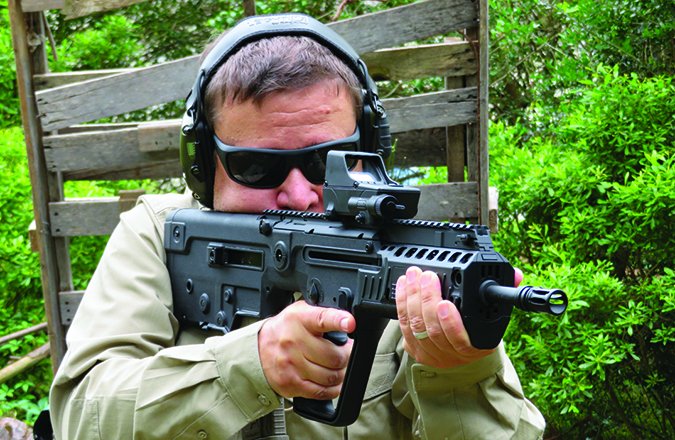
Basically, then, everything from reloading to grip and handling changes when running a bullpup, so we wanted to see which bullpup we could adapt to more easily. Our quartet of bullpups included three chambered in 5.56mm, which was the IWI Tavor X95 XB16, the Steyr AUG A3 M1, and Kel-Tec’s RDB. The fourth bullpup was the FN Model PS90 Standard chambered in 5.7x28mm. This is a nice sampling of bullpups because the AUG could be considered the Rolex of bullpups, while the Kel-Tec is the Timex at a much lower price. All performed without malfunctions, so they all took a licking and kept on ticking. One, the IWI, was modular and offered easy caliber conversion. All were optics-ready except the AUG (pronounced “A-U-G” not “awg”), which came from the factory with an optic. One, the FN, we had to study to even determine how to pick it up and shoulder it, but when we did we experienced a clear engineering solution to bad bullpup ergonomics. With the Kel-Tec, we ended up calling it the working man’s bullpup. Nothing fancy, but it kept pace with the other three. In hand, the bullpups feel like an AR-15 short-barreled rifle, or SBR, which require special tax stamps to own.
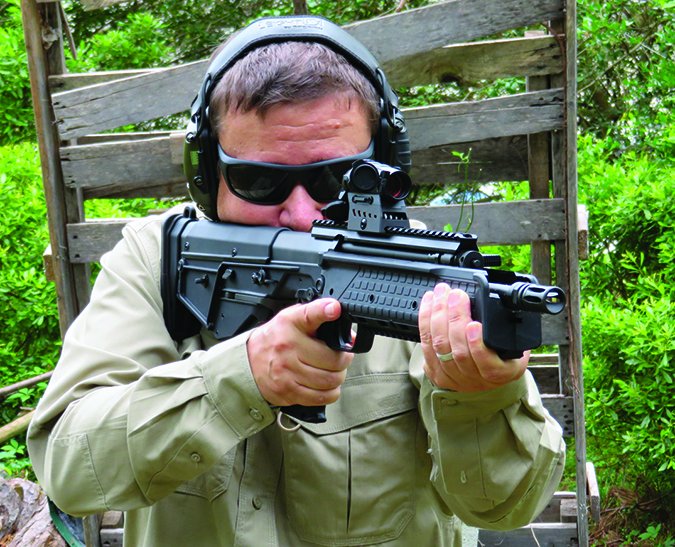
We tested all except the AUG with either a SIG Romeo4B or a Mepro Tru-Dot RDS. Both are red-dot sights that excel at close-to-medium range. At ranges out to 100 yards, the dot suffices for most targets, but a crosshair reticle would shrink groups. The Romeo4B allows the user to toggle between four different reticles: 2-minute-of-angle dot, 2-MOA dot with ballistic holds, 2-MOA/65 MOA Circle Dot, or 2-MOA/65 MOA Circle Dot with ballistic holds. The ballistic holdover points are calibrated for 5.56 NATO and 7.62x51mm NATO rounds. A feature we liked was the activated motion sensor that immediately powers up illumination when the red dot senses motion and powers down when it does not to extend battery life. The Mepro Tru-Dot RDS we like and have used it for a number tests on AR-style firearms. It features a 1.8-MOA dot reticle and is constructed with an aluminum body and tough polymer frame around a large viewing window. This sight is easy to use when shooting with both eyes open. It runs on one AA battery, and you don’t need any tools to change the battery or adjust the sight. It also turns off when not in use to conserve battery life. Both are good choices for AR applications, and as we found out, these bullpups, like ARs, have a straight comb and optics needed to be mounted high. Be aware that a bullpup is capable of hitting targets at the same ranges as an AR-15 with an appropriate optic.
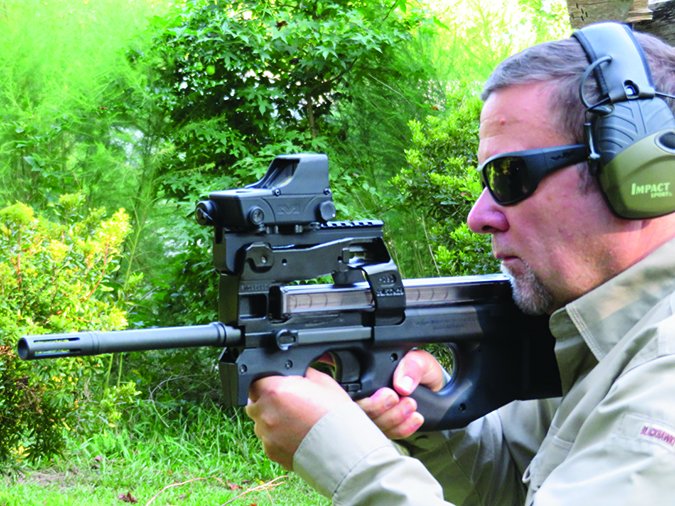
Two of the bullpups — the IWI and Kel-Tec — are compatible with standard AR-15 magazines, which we appreciated since we have plenty of AR-15 magazines on hand. We used Brownells’ aluminum-body magazines (Brownells.com, $14) Magpul Pmags (Brownells.com, $12.30), and Hexmag tubes (Brownells.com, $12); all were 30-rounders. The AUG and FN used proprietary magazines. Like an AR-15, the FN, IWI, AUG, and Kel-Tec allow the operator to keep his firing hand on the grip while performing a reload with the support hand.
Range Data: Steyr, IWI, Kel-Tec
| Aguila 5.56mm NATO 62-gr. FMJ-BT | Steyr AUG A3 M1 | IWI Tavor X95 XB16 | Kel-Tec RDB |
| Average velocity | 2940 fps | 2946 fps | 3040 fps |
| Muzzle energy | 1190 ft.-lbs. | 1195 ft.-lbs. | 1272 ft.-lbs. |
| Smallest group | 1.06 in. | 1.47 in. | 2 in. |
| Average group | 1.70 in. | 1.83 in. | 2.64 in. |
| Federal Fusion 223 Rem. 62-gr. Fusion | |||
| Average velocity | 2861 fps | 2867 fps | 2943 fps |
| Muzzle energy | 1127 ft.-lbs. | 1132 ft.-lbs. | 1193 ft.-lbs. |
| Smallest group | 1.08 in. | 1.68 in. | 1.87 in. |
| Average group | 1.90 in. | 1.85 in. | 2.52 in. |
| SIG Elite 223 Rem. 77-gr. OTM Match | |||
| Average velocity | 2330 fps | 2331 fps | 2424 fps |
| Muzzle energy | 928 ft.-lbs. | 929 ft.-lbs. | 1005 ft.-lbs. |
| Smallest group | 1 in. | 1.70 in. | 1.90 in. |
| Average group | 2 in. | 1.93 in. | 2.95 in. |
Range Data: FN
| FN PS90 | FN 5.7x28mm 40-gr. V-Max | Federal American Eagle 5.7x28mm 40-gr. FMJ |
| Average velocity | 2063 fps | 2006 fps |
| Muzzle energy | 378 ft.-lbs. | 357 ft.-lbs. |
| Smallest group | 1.09 in. | 1.10 in. |
| Average group | 2.09 in. | 2.08 in. |
To collect accuracy data, we fired three-shot groups from a bench using a rest. Distance: 100 yards with optics. We recorded velocities using a ProChrono digital chronograph 15 feet from the muzzle.
The three brands of AR-suitable ammunition we tested included Aguila 5.56mm NATO with a 62-grain FMJ bullet, 223 Remington Federal Fusion loaded with a 62-grain soft point, and SIG Sauer’s 223 Remington ammo loaded with a 77-grain Open-Tip Match (OTM) bullet. For the FN, we used FN 5.7x28mm 40-grain V-Max and Federal American Eagle 40-grain FMJs. We noticed big differences in recoil and muzzle blast between the 5.56 NATO and 5.7x28mm ammo. The 5.7x28mm ammo was similar to shooting 22 Magnum ammo — minimal recoil and not as much muzzle blast as the 5.56mm NATO.
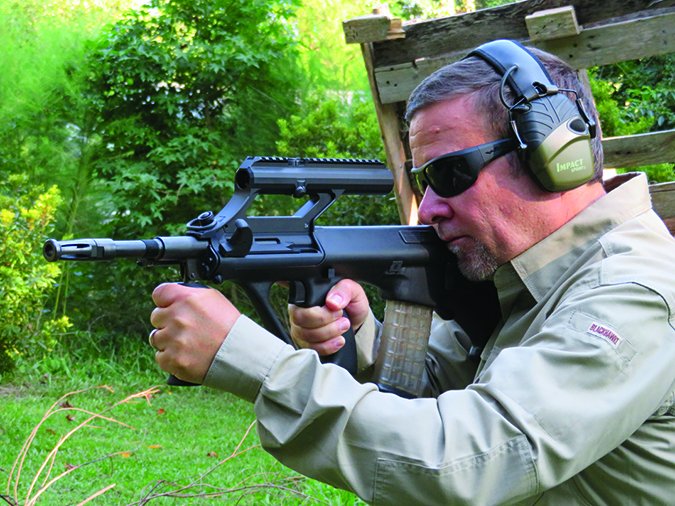
One aspect to remember with a bullpup is the price. These are not inexpensive choices, costing from a few hundred to a thousand dollars more than the typical AR. The attraction with bullpups is reduced overall length and better maneuverability. We sneaked down hallways and around doorways with both an unloaded AR-15 and the unloaded bullpups to get a sense of the differences. Bullpups, hands down, are more maneuverable. Here’s what else we learned about these bullpups:
IWI Model Tavor X95 XB16 5.56mm NATO, $2000
GUN TESTS GRADE: A-
The X95 is modular, allowing caliber conversions — a big plus. The rails easily allow a user to attach accessories. It also runs on AR-15 style magazines. The trigger was mushy.
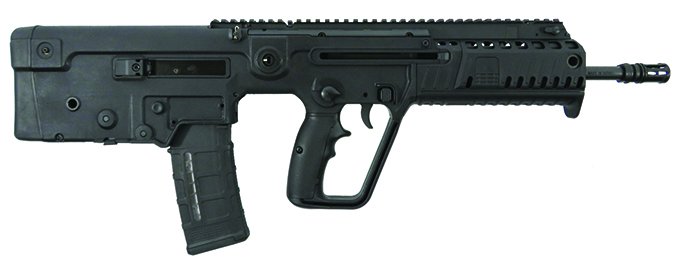
| ACTION TYPE | Semi-automatic; adjustable long-stroke gas piston; closed rotating bolt |
| OVERALL LENGTH | 26.13 in. |
| OVERALL HEIGHT (w/ sights) | 11.25 in. |
| WEIGHT UNLOADED | 7.9 lbs. |
| WEIGHT LOADED (30-rd. mag) | 8.9 lbs. |
| RECEIVER | Steel; polymer shell |
| BARREL | 16.5 in.; 1:7 RH twist; chrome-moly-vanadium, hammer-forged; chrome lined |
| MUZZLE DEVICE | A2 Birdcage, 1/2×28 TPI |
| BUTTSTOCK | Reinforced polymer fixed; rubber pad |
| LENGTH OF PULL | 15.8 in. |
| MAGAZINE | (1) 30-rd.; polymer NATO STANAG |
| REAR SIGHT | Adjustable folding; optic ready |
| FRONT SIGHT | Adjustable folding; optic ready |
| TRIGGER | 7.3 lbs.; single stage |
| SAFETY | 2-position lever |
| WARRANTY | 5 years |
| TELEPHONE | (717) 695-2081 |
| WEBSITE | IWI.us |

The Tavor X95 is the newest IWI bullpup design and is an upgraded version of the battle-proven SAR design, which has been in Israeli Military service since 2001. The IWI features a long-stroke piston system that we found was clean running and reliable. A gas regulator allows the user to adjust the action to the cartridge. The mechanism is encased in a rugged polymer shell.
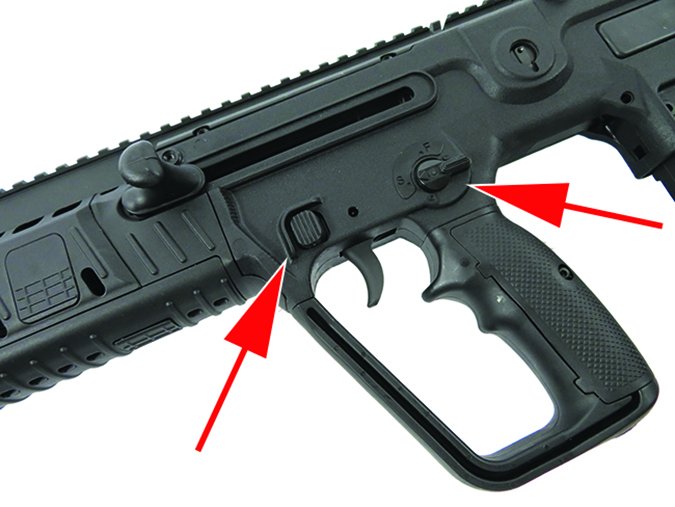
Disassembly of the X95 is simple and, in fact, the ability to swap calibers is what sets the IWI apart from the other bullpups. IWI offers optional 9mm and 300 BLK conversion kits. Pull out one pin in the butt and rotate the butt pad down. You can then pull the recoil mechanism out. The gas piston can also be adjusted so the X95 can be optimized when shooting with a suppressor.
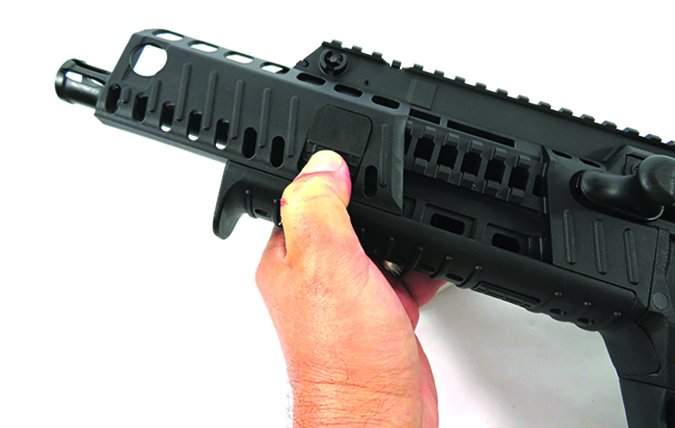
The operating handle is close to the operator for easier manipulation in cramped spaces. The charging handle can also be reversed on the opposite side, depending on the shooter’s preference, a nice feature, we thought. The magazine release operates similar to an AR-15 magazine release. The forearm has Picatinny rails at the 3, 6, and 9 o’clock positions with removable rail covers. The rails allow a user to add a light or laser or other accessories.
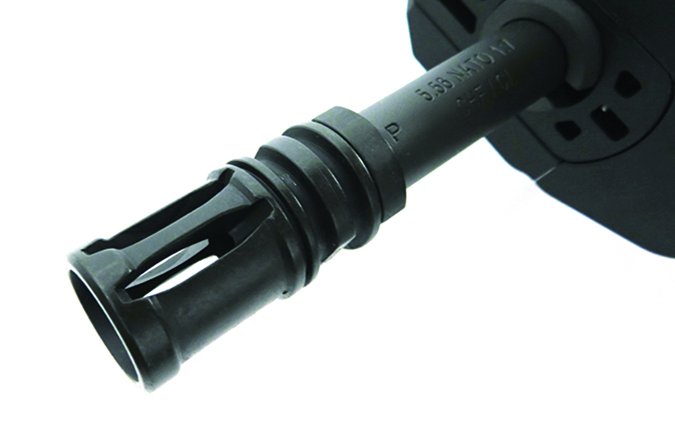
The Tavor-style pistol grip with the large loop can be swapped out by removing one screw so a standard pistol grip can be mounted. We liked the Tavor grip guard because we could jam it up against a barrier to steady our aim, just like we could with the AUG. The bolt release is small and low profile, again for better manipulation in tight conditions like a vehicle.
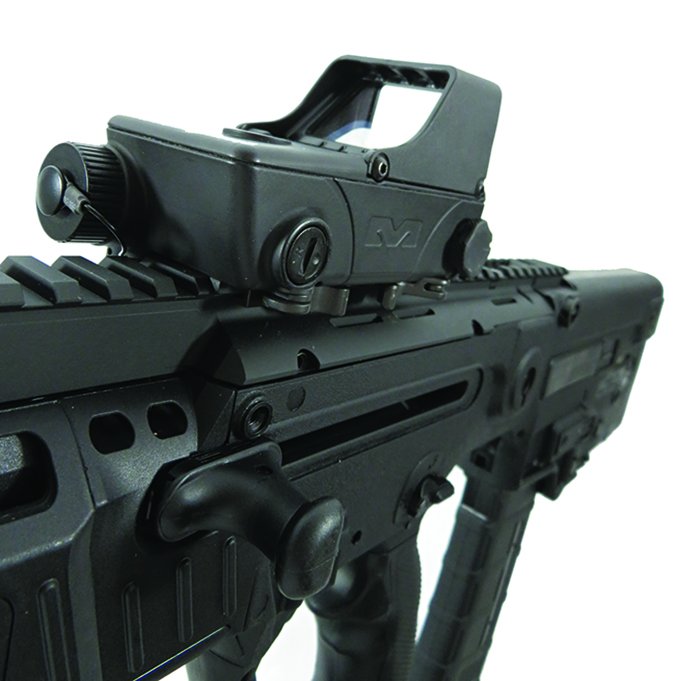
The controls, except for the bolt release, were similar to those on an AR-15. The safety selector rotates like that on an AR-15 and can be reversed for left-hand use. The ambidextrous magazine release can be operated with the trigger finger. The charging handle is located on the left side, so cocking the X95 with your support hand and holding the pistol grip with the firing hand provides plenty of leverage. Inserting magazines is where our team needed ramp-up time. Training yourself to move the fresh magazine behind the pistol grip took some getting used to, but we found that we adapted quickly.
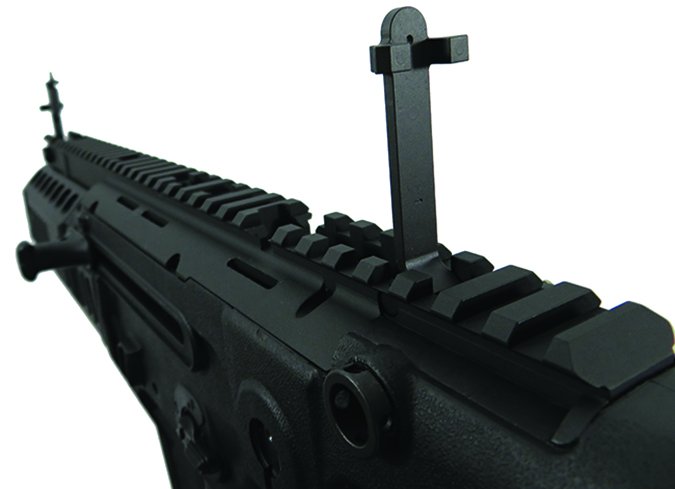
Starting out at 25 yards, we used a rest and found the X95 could make five-shot groups into one a ragged hole. Performing fast firing drills with magazine loads, we ran the X95 for speed. A lip on the forend allows an operator to grip the rifle as far forward as possible while limiting the chance of grabbing the muzzle.
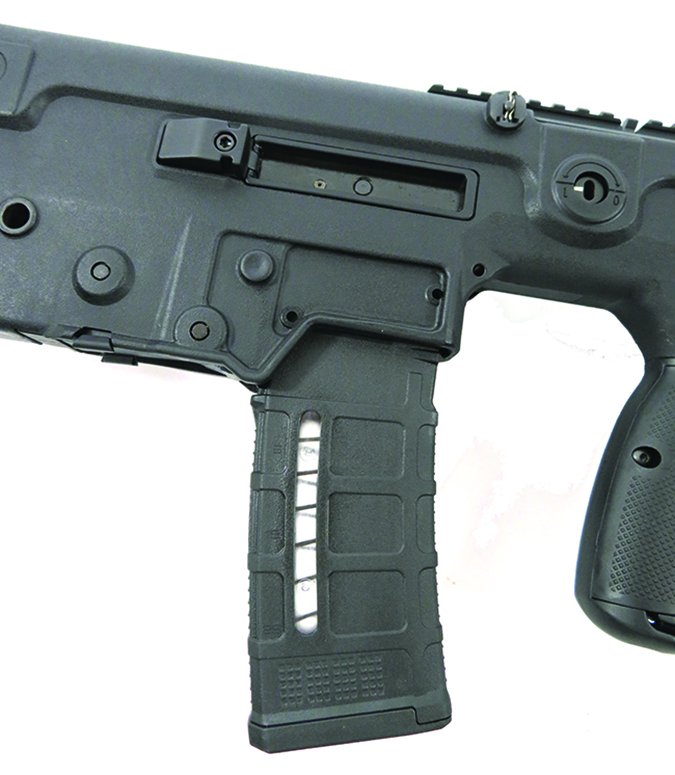
Recoil was mild and empties were thrown well away via an ejection port just under the shooter’s nose. Magazine swaps, at first, were awkward as we learned to run the bullpup. The bolt release is just to the rear of the magazine and can be manipulated in one motion. Dump magazine, insert magazine, and press the release to slam the bolt forward.
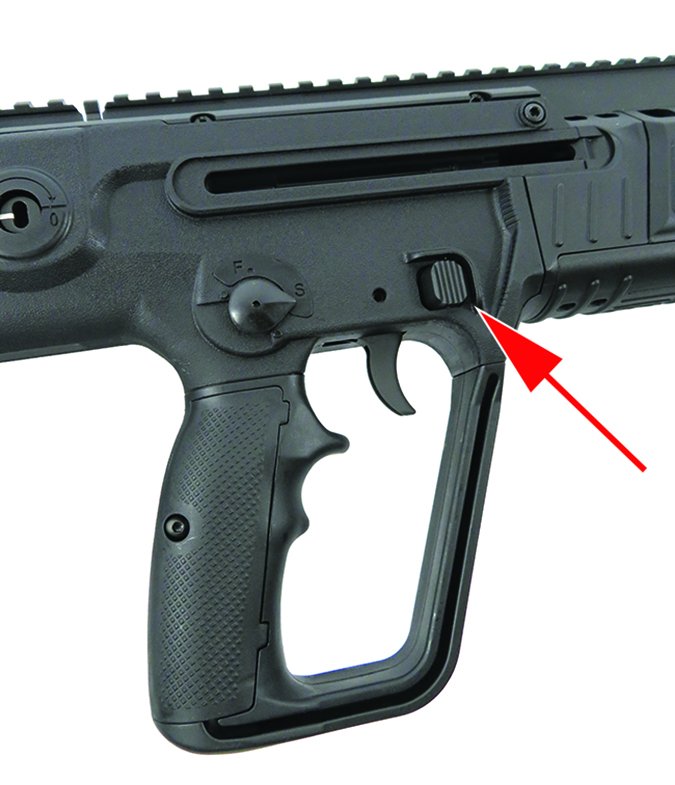
The trigger was a bit heavy, and this is a trait of most bullpups because the trigger mechanism is longer, having to reach rearward to fire the mechanism. It broke, on average, at 6.8 pounds — not particularly helpful at the 100-yard range, but it was a trigger a user can easily adapt to. Using a red dot, we were able to get decent groups that averaged just under 2 MOA. The IWI ran strong with no malfunctions.
Our Team Said: The IWI is an easy bullpup to adapt to because many controls are like an AR’s. We liked that caliber conversions were available. We liked that the rails could be hidden with the removable panels, and the IWI easily allowed the user to add accessories. Downside: The trigger was mushy. At $2000, we feel this is a good investment for a cutting-edge bullpup design with traditional AR-15 style features.
Kel-Tec Model RDB 17 5.56mm NATO, $1100
GUN TESTS GRADE: A- (Best Buy)
The RDB is the working man’s bullpup. It is not as refined as the others, but is still very capable. It’s a good choice if you want a bullpup at a reasonable cost. However, most places we checked didn’t have them in stock.

| ACTION TYPE | Semi-automatic; adjustable gas piston |
| OVERALL LENGTH | 27.3 in. |
| OVERALL HEIGHT (not including optic) | 7.5 in. |
| WEIGHT UNLOADED | 6.7 lbs. |
| WEIGHT LOADED (30-rd. mag) | 7.7 lbs. |
| RECEIVER | 4140 steel; polymer shell; bottom ejection |
| BARREL | 17.4 in.; 1:7 RH twist |
| MUZZLE DEVICE | A2 Birdcage, 1/2×28 TPI |
| BUTTSTOCK | Fixed; removable rubber pad |
| LENGTH OF PULL | 14.25 in. |
| MAGAZINE | (1) 20-rd. ambidextrous release |
| SIGHTS | MIL-STD 1913 top rail |
| TRIGGER | 5.5 lbs., single stage |
| SAFETY | Ambidextrous 2-position lever |
| WARRANTY | Lifetime |
| TELEPHONE | (321) 631-0068 |
| WEBSITE | KelTecWeapons.com |
| MADE IN | Florida |
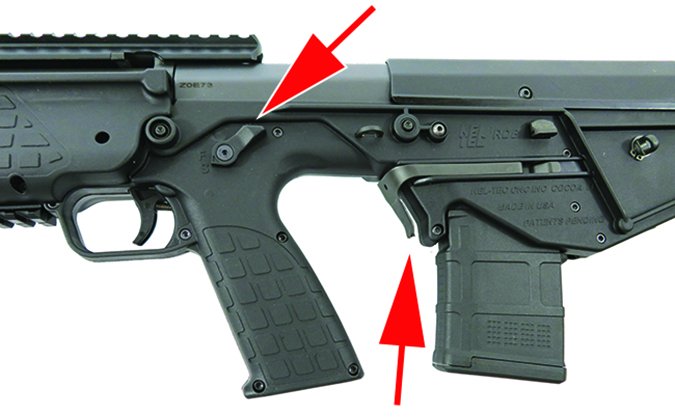
The price listed above is the average price from 10 online sites, none of which had the RDB in stock. The MSRP is $1272. The Kel-Tec RDB is a no-frills bullpup that is very functional and simple. The RDB uses two polymer halves that sandwich around a steel action and barrel. The gas-piston system has a gas regulator so a user can regulate the rifle to run on all sorts of ammunition and with a suppressor. The gas regulator can be adjusted with the open mouth from an empty 5.56 NATO case. It’s click-adjustable and Kel-Tec recommends firing a round after adjusting the regulator to test reliability. It comes from the factory ready to run on standard M193-type ammo.
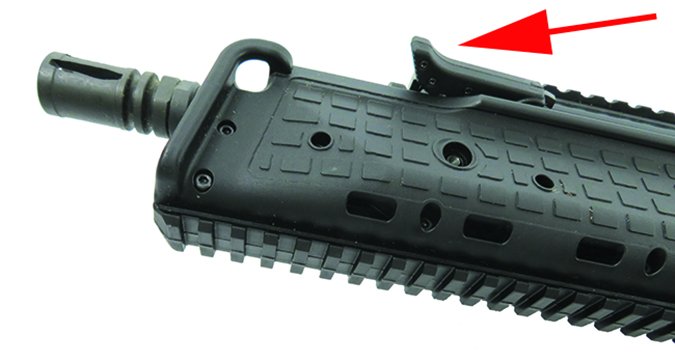
It features a left-side charging handle that is non-reciprocating. It locks against the forend when not being used. The RDB’s cocking handle required a longer reach than the other bullpups, but it provided good leverage when cocking the weapon with the support hand on the charging handle and the firing hand on the grip.
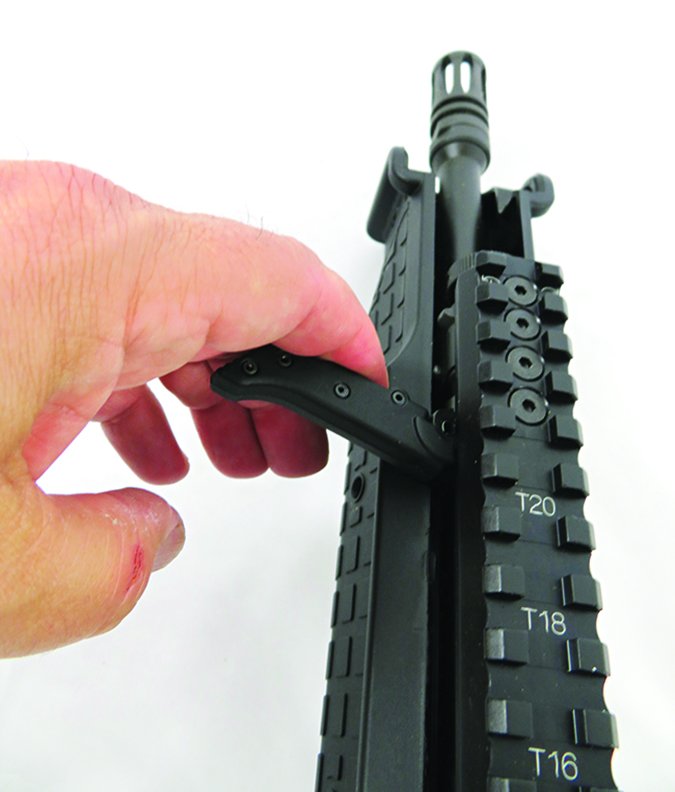
The outside texture of the polymer features a very coarse grid pattern that is comfortable and offers plenty of grip purchase. Picatinny rails at 12 and 6 o’clock allow mounting of an optic or vertical grip.
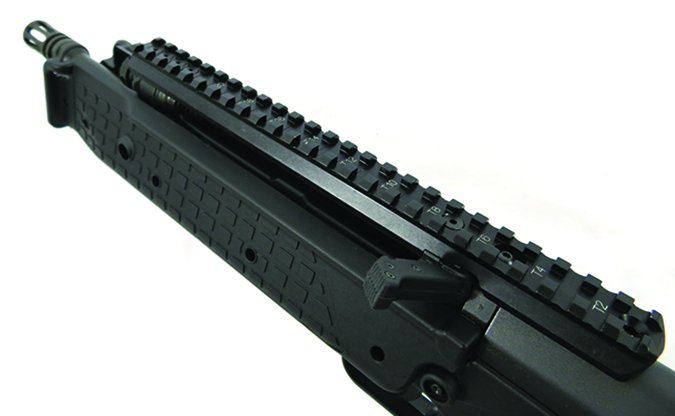
The controls include an ambidextrous rotating safety selector that is easily manipulated by the thumb of the shooting hand like an AR-15, but it requires less rotation than the typical AR-15 selector. The magazine-release lever is also suited for left- or right-hand users. The lever is designed so the magazine can fall free as the operator grasps the magazine to remove it. Because the operator’s hand naturally falls on it, the simple metal magazine release must be pressed to drop or strip away the magazine.

Field-stripping the Kel-Tec is simple. Push out two pins, and it disassembles similar to an AR-15. Rotate the grip downward, and the barrel and bolt carrier can be removed from the stock/grip assembly.
The RDB uses a unique downward ejecting system. As the bolt moves rearward, the extractor pulls the cases out of the chamber and into dual ejectors that push the case down a chute so hot empties fall at the shooter’s feet.
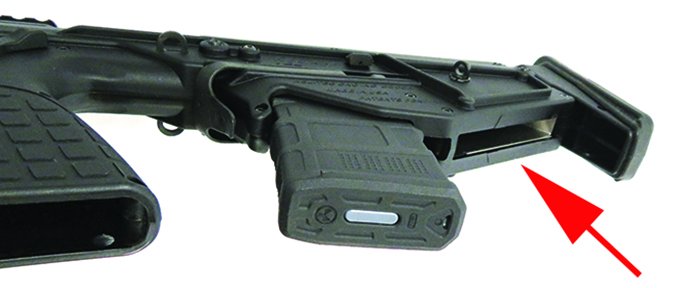
At 25 yards using a rest, we could create one large hole in the target. At 100 yards, the accuracy ranged between 2.5 to 3 MOA. In speed testing, the RDB ran well with no malfunctions. It also felt more like an AR due to the handguard, which incorporated a ridge so your support hand did not get too close the muzzle. The trigger was not as refined as we would like, but it was usable.
Our Team Said: The Kel-Tec is a basic bullpup that, in our opinion, will get the job done. If you have a need to own a bullpup and have a limited budget, this would be our pick, thus its Best Buy ranking.
Steyr Model AUG A3 M1 w/3X Optic 5.56mm NATO, $2,599
GUN TESTS GRADE: A- (Our pick)
The AUG is iconic and is the benchmark in bullpup design. The long LOP takes a bit more handling by a small-statured operator. We’d prefer the NATO variant that uses AR-15 magazines.

| ACTION TYPE | Semi-automatic; adjustable short-stroke gas piston |
| OVERALL LENGTH | 28.15 in. |
| OVERALL HEIGHT (w/ optic) | 11.25 in. |
| WEIGHT UNLOADED | 8.8 lbs. |
| WEIGHT LOADED (30-rd. mag) | 9.8 lbs. |
| RECEIVER | Aluminum; black polymer shell |
| BARREL | 16.375 in.; 1:9 RH twist; chrome lined |
| MUZZLE DEVICE | 4-slot brake, 1/2×28 TPI |
| BUTTSTOCK | Fixed; rubber pad |
| LENGTH OF PULL | 15 in. |
| MAGAZINE | (1) 30-rd. polymer double stack |
| SIGHTS | Integral 3x optic |
| TRIGGER | 10.2 lbs., single stage |
| SAFETY | 2-position crossbolt button |
| WARRANTY | None |
| TELEPHONE | (205) 417-8644 |
| WEBSITE | SteyrArms.com |
| MADE IN | Bessemer, AL |
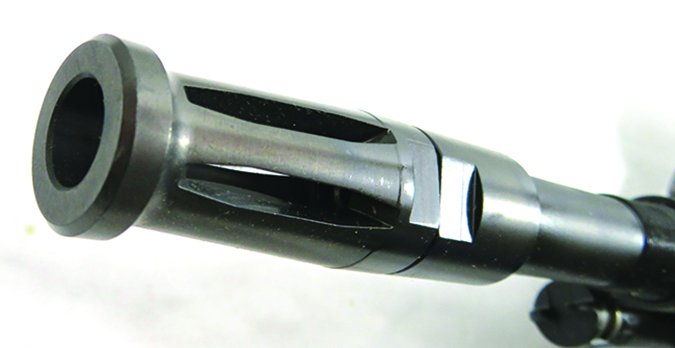
The AUG is the benchmark by which all other bullpups are judged. It is modular in design and has a reputation for reliability and minimal maintenance. This iconic bullpup has been in service with a variety of police forces and at least 20 militaries since 1978. The AUG has a long history of proven performance. Even though the design is nearly 40 years old, it still looks futuristic. The AUG A3 M1 Optics is the latest variant, which features a traditional AUG scope plus the addition of three Picatinny rail sections to mount accessories. This AUG is also made in the U.S.
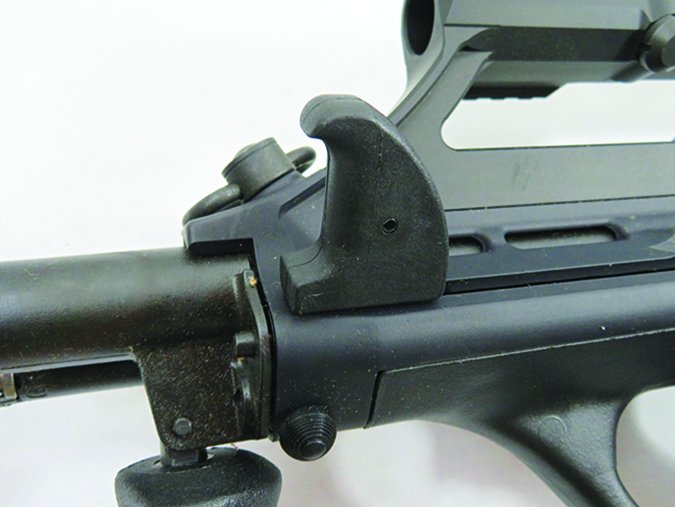
The AUG features a short-stroke gas-piston system with exhaust gas venting out of the front of the rifle. The piston has a valve that is adjustable so the AUG can run on all types of ammo and with a suppressor. The action was smooth and easy to manipulate with the non-reciprocating cocking handle. We had plenty of leverage to cock the weapon and lock the handle in a notch in the receiver. The user can then slap the handle down to allow the bolt to spring forward and load the chamber. We liked the simplicity of use. The bolt carrier rides on two stainless-steel guide rods in the receiver, which attaches to the fiberglass-reinforced polymer stock.
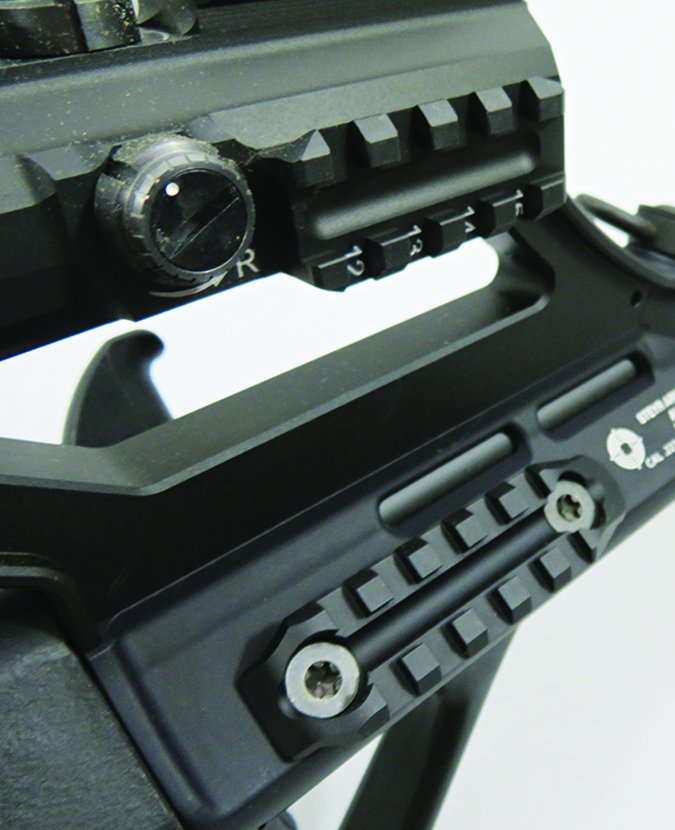
The AUG disassembled quickly, what Steyr calls “expedited disassembly,” which means the barrel can be removed in seconds without the use of tools. The AUG quickly field-strips into six main components. Barrels with longer lengths are available, but our sample had a 16-inch, cold-hammer-forged barrel with 1:9-inch-twist rifling and a slotted flash hider. The vertical foregrip can folded up or rotated down to a vertical grip. We liked this set up and ensured we grasped the vertical grip when shooting offhand. Another feature is the ability of the user to convert the AUG to left-hand operation, which requires replacing of the right-hand bolt with the optional left-hand bolt (SteyrArms.com, $249) and swapping the ejection port cover.

This newest AUG is equipped with a Picatinny rail on the top side if you want to mount a second optic. Our sample had an integrated 3x optic, which was bright and clear. Like an optic for an AR, the optic on the AUG needs to be mounted high. The scope was positioned 1.95 inches over the stock comb and was easy to aim, with a solid cheek weld. The turret requires a coin or flat screwdriver to make windage and elevation changes. The reticle was a medium crosshair with a range-finding circle, which we thought was well suited for this bullpup. The scope itself had a topside Picatinny rail so the shooter could mount a CQB red dot or reflex sight. On the right side of the receiver was another short rail. Also different from previous AUGs is the front sling swivel. This new variant features a Vltor quick-detach sling swivel.
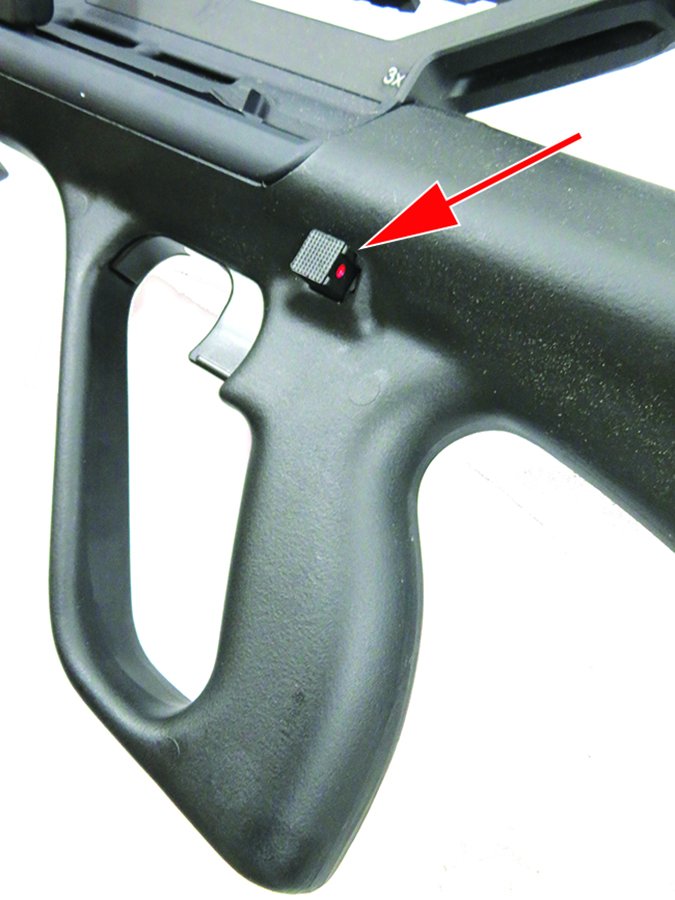
Our sample used Steyr proprietary magazines, though a NATO version of the AUG accepts standard STANAG (AR-15) magazines. We liked the clear AUG magazine with the waffle texture, but we could see the NATO version would be more practical for a shooter who already has AR-15 magazines. Additional magazines are available in 10-, 30- or 42-round configurations from SteyrArms.com for $45 to $48.
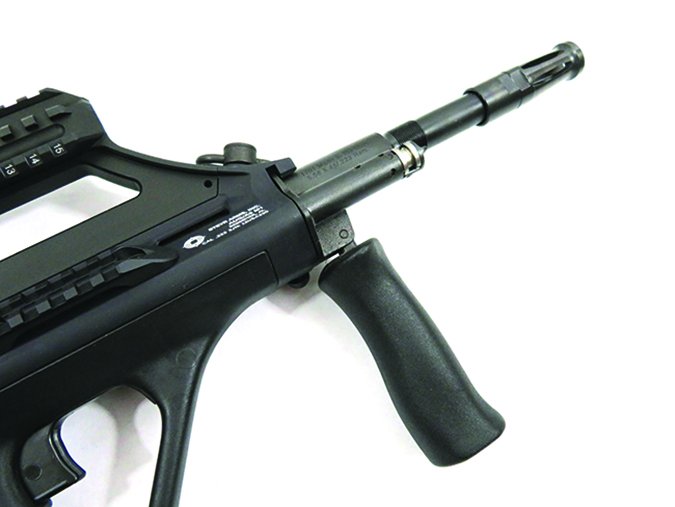
Going hot, we found the fastest way to perform magazine changes was to use our support hand, like with an AR-15 except we grabbed a fresh magazine first then pressed the magazine-catch release and stripped out the empty magazine then inserted the loaded one. Your work space is more cramped when running a bullpup, and that is one of the trade-offs. Another trade-off is the trigger. The AUG trigger was large and flat as well as glove friendly. It slides rearward with some take-up. Not crisp, but serviceable. The firing grip is also protected by a handguard. The IWI uses a similar set up to protect the trigger if the bullpup is accidentally dropped.
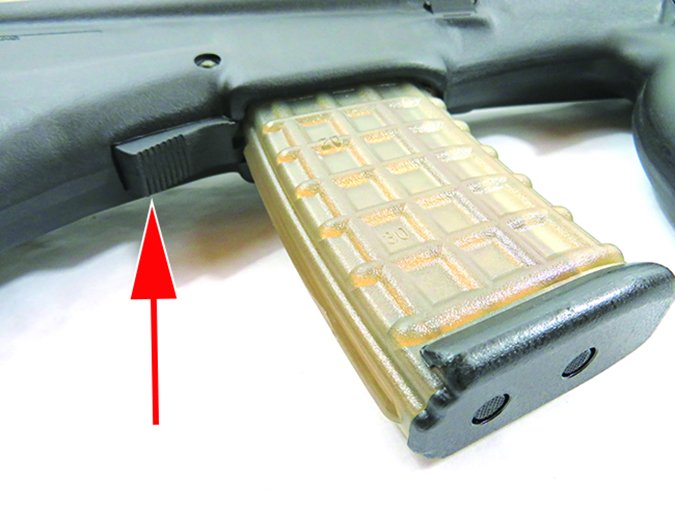
The safety is a crossbolt type with a large square button. The bolt release is located above the magazine catch, and both are manipulated with the support hand. At 25 yards, we found the AUG was surgical and spit out brass to right through the ejection port just under our nose. Using a rest out to 100 yards, we could squeeze out five-shot groups that averaged less than 2 inches. The AUG had no malfunctions.
Our Team Said: The Steyr AUG A3 M1 w/3X optic is a well-made rifle with great ergonomics. It is also expensive. We liked this iconic option the best of these closely-ranked products, and if it is in budget, we’d go for it ahead of the others.
FN Model PS90 Standard 3848950460 5.7x28mm, $1449
GUN TESTS GRADE: A-
The FN takes the bullpup design to the next level of compactness. The short LOP made the PS90 quick to the shoulder. This is a unique firearm in an equally unique caliber and as such, would make an excellent defense choice.

| ACTION TYPE | Semi-automatic; closed bolt, blowback |
| OVERALL LENGTH | 26.23 in. |
| OVERALL HEIGHT (w/ optic) | 8.3 in. |
| WEIGHT UNLOADED | 6.6 lbs. |
| WEIGHT LOADED (30-rd.) | 7 lbs. |
| RECEIVER | Alloy; matte-black polymer shell, bottom eject |
| BARREL | 16.04 in.; 1:9 RH twist; hammer forged, chrome lined |
| MUZZLE DEVICE | Ported muzzle brake |
| BUTTSTOCK | Fixed thumbhole; rubber buttpad; forward handstop; molded-in rear sling attachment point |
| LENGTH OF PULL | 13.5 in. |
| MAGAZINE | (1) 30-rd.; translucent polymer |
| SIGHTS | MIL-STD 1913 top rail; backup iron sight |
| TRIGGER | 6 lbs., single stage |
| SAFETY | 2-position rotating lever |
| WARRANTY | Implied lifetime |
| TELEPHONE | (800) 635-1321 |
| WEBSITE | FNAmerica.com |
| MADE IN | Belgium |
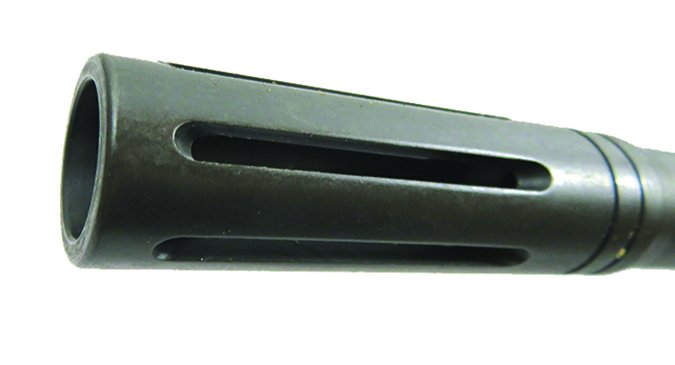
The price above is MSRP, but we found new PS90s selling for around $1400 in several places, including Cabela’s. The PS90, in our opinion, takes the bullpup design to the next level. It is light weight, ambidextrous, compact, and has great ergonomics.
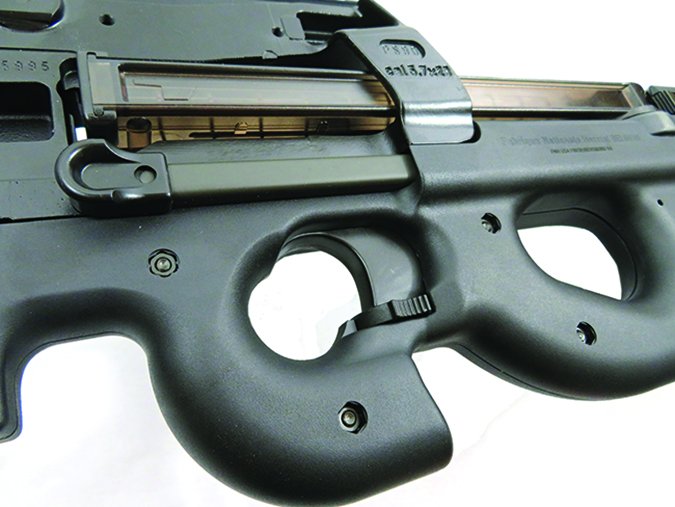
The big difference between the PS90 and our other test bullpups is the cartridge. The PS90 is chambered in 5.7x28mm, which is a high-velocity small-caliber bullet that is similar to a 22 Hornet. The P90 was designed in the mid 1980s and has been in use with military and police forces in more than 40 nations since 1991. It was designed as a PDW (Personal Defense Weapon) along with the 5.7x28mm cartridge to replace the 9mm and pistols and submachine guns. FN also chambers this round in the FN Five-seveN pistol. Comparing bullpups here, in our opinion the 5.56mm cartridge models offer more options in loads and use, such as target and hunting loads, and cartridges are found in nearly any retail store. We found this round to be very accurate with minimal recoil and not a lot of muzzle blast.
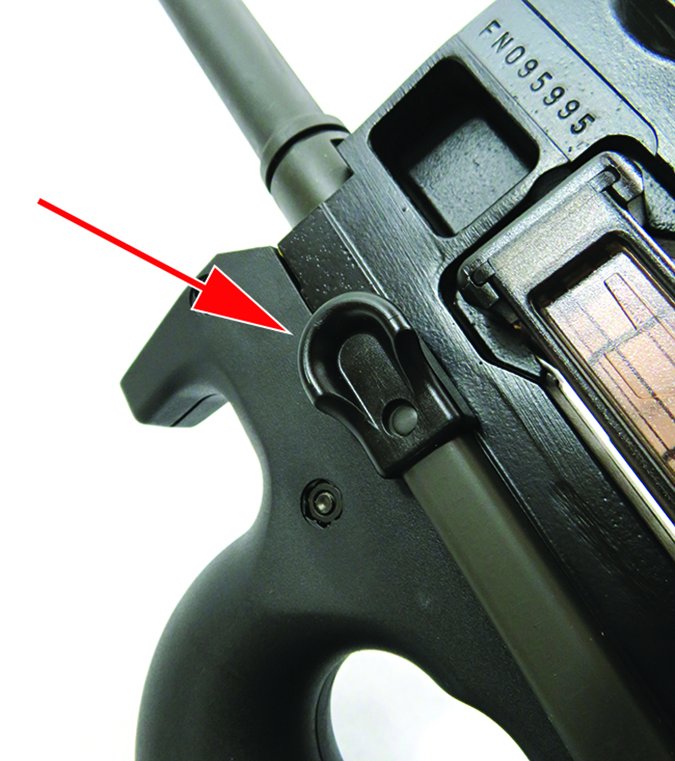
The PS90 is a semi-automatic civilian version of the P90. The PS90 field-strips similar to the AUG. The barrel and optic-support group pulls out of the polymer frame/trigger group, what we’ll call the stock. The hammer group is pulled from the rear of stock butt. Simple. Integrated into the stock are two hand grips. The rear firing grip is similar to a thumbhole stock. The front grip allows the user to grasp the grip and place his thumb inside the trigger guard. Sounds confusing until you actually shoulder the PS90 and see how naturally it feels. The front grip also has a lip so your support hand does not get near the barrel. This is important with the PS90 and all the other bullpups since the bare, unprotected barrel is close to the operator’s support hand. We’d suggest using gloves, when possible, just in case you fall into AR mode and try to grasp the barrel thinking it is like an AR handguard.
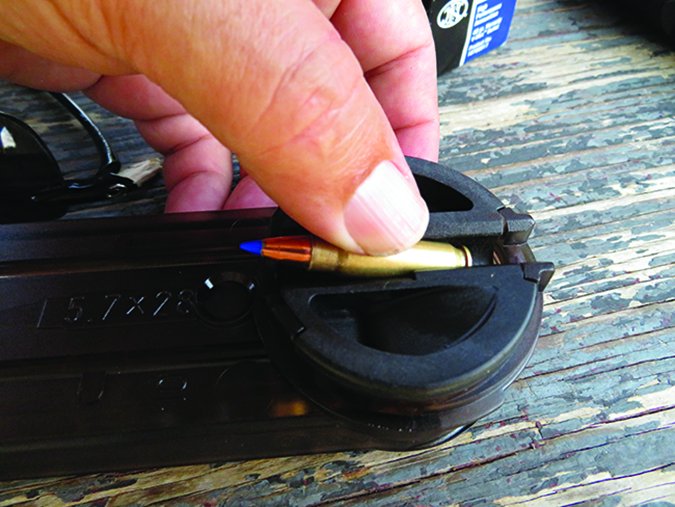
Our sample has a 16-inch barrel with a slotted muzzle brake. The optic bridge is metal and holds the barrel and positions the magazine. It also features a Picatinny rail to mount an optic, and in the bridge are backup iron sights, basically a peep sight paired with a rear hole and post that are small but usable. Controls consist of ambidextrous magazine latches, cocking handles, and safety selector. The cocking handles are rounded ears on either side of the weapon, so it is pretty effortless to cock the PS90. The safety selector is a disc under the trigger, and it rotated to place the on Safe or Fire. The magazine is a rectangular clear polymer box that lays on the top of the PS90 and inside the optic bridge.
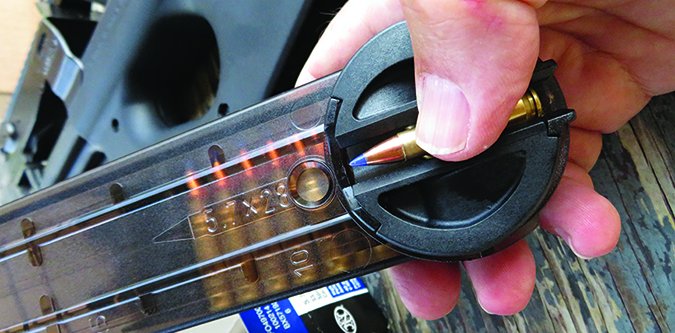
Cartridges from the magazine are rotated 90 degrees as they are chambered from above, unlike the other magazines, which keep the stack of cartridges parallel and below the chamber. This magazine was easy to load and held 30 rounds. We liked the magazine set up because we could easily see the remaining round count while still keeping the rifle in the ready position. Both 10- and 50-round magazines are available (FNestore.com; $29). Empty brass is ejected from the bottom of the stock, similar to the Kel-Tec RDB. When the magazine was empty, the shooter uses the support hand to press the magazine catch, pull the empty magazine out, insert a loaded magazine, and snap it into place. It takes slightly longer than loading an AR-15 magazine.
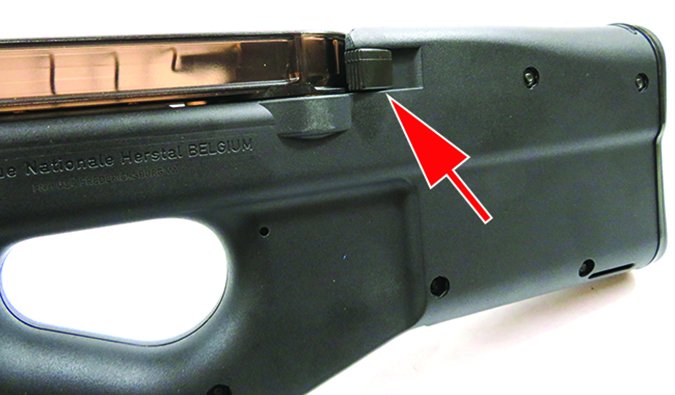
Going hot with the PS90 at 25 yards, we found this bullpup excels in rapid fire. It is easy to shoot with negligible recoil, similar to shooting a rimfire cartridge. The short length of pull — 13.5 inches — means it shoulders quickly. At 100 yards, we found the PS90 was accurate, and because it was small, we needed to rest it on the bottom of the grip.
In our opinion, bullpup triggers are their weak point, and this test convinced us. The trigger pull on the PS90 measured about 6 pounds, and it was mushy, but like all the other triggers, serviceable. They are by no means match-style triggers. The PS90’s trigger slides backward like on the AUG, while the Kel-Tec and IWI triggers pivot.
Our Team Said: The PS90 is well made, reliable, and compact. The cartridge is not as popular as the 5.56mm, but it is proven. If you have a Five-seveN pistol, the PS90 would be a great companion piece. If a cutting-edge bullpup is your desire, then the PS90 is great choice.
Written and photographed by Robert Sadowski, using evaluations from Gun Tests team testers.



























